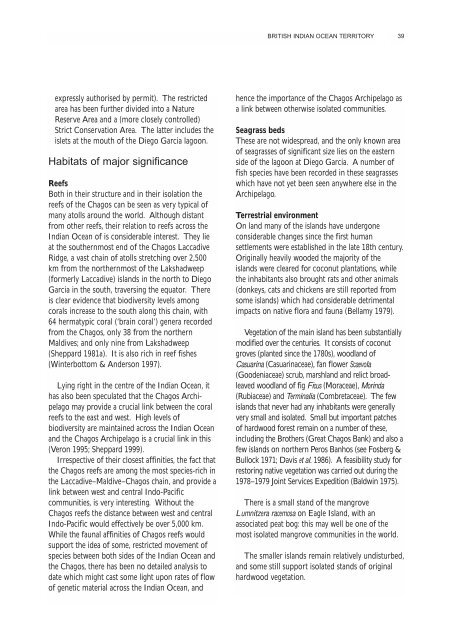Biodiversity: the UK Overseas Territories - WIDECAST
Biodiversity: the UK Overseas Territories - WIDECAST
Biodiversity: the UK Overseas Territories - WIDECAST
You also want an ePaper? Increase the reach of your titles
YUMPU automatically turns print PDFs into web optimized ePapers that Google loves.
BRITISH INDIAN OCEAN TERRITORY<br />
39<br />
expressly authorised by permit). The restricted<br />
area has been fur<strong>the</strong>r divided into a Nature<br />
Reserve Area and a (more closely controlled)<br />
Strict Conservation Area. The latter includes <strong>the</strong><br />
islets at <strong>the</strong> mouth of <strong>the</strong> Diego Garcia lagoon.<br />
Habitats of major significance<br />
Reefs<br />
Both in <strong>the</strong>ir structure and in <strong>the</strong>ir isolation <strong>the</strong><br />
reefs of <strong>the</strong> Chagos can be seen as very typical of<br />
many atolls around <strong>the</strong> world. Although distant<br />
from o<strong>the</strong>r reefs, <strong>the</strong>ir relation to reefs across <strong>the</strong><br />
Indian Ocean of is considerable interest. They lie<br />
at <strong>the</strong> sou<strong>the</strong>rnmost end of <strong>the</strong> Chagos Laccadive<br />
Ridge, a vast chain of atolls stretching over 2,500<br />
km from <strong>the</strong> nor<strong>the</strong>rnmost of <strong>the</strong> Lakshadweep<br />
(formerly Laccadive) islands in <strong>the</strong> north to Diego<br />
Garcia in <strong>the</strong> south, traversing <strong>the</strong> equator. There<br />
is clear evidence that biodiversity levels among<br />
corals increase to <strong>the</strong> south along this chain, with<br />
64 hermatypic coral (‘brain coral’) genera recorded<br />
from <strong>the</strong> Chagos, only 38 from <strong>the</strong> nor<strong>the</strong>rn<br />
Maldives; and only nine from Lakshadweep<br />
(Sheppard 1981a). It is also rich in reef fishes<br />
(Winterbottom & Anderson 1997).<br />
Lying right in <strong>the</strong> centre of <strong>the</strong> Indian Ocean, it<br />
has also been speculated that <strong>the</strong> Chagos Archipelago<br />
may provide a crucial link between <strong>the</strong> coral<br />
reefs to <strong>the</strong> east and west. High levels of<br />
biodiversity are maintained across <strong>the</strong> Indian Ocean<br />
and <strong>the</strong> Chagos Archipelago is a crucial link in this<br />
(Veron 1995; Sheppard 1999).<br />
Irrespective of <strong>the</strong>ir closest affinities, <strong>the</strong> fact that<br />
<strong>the</strong> Chagos reefs are among <strong>the</strong> most species-rich in<br />
<strong>the</strong> Laccadive–Maldive–Chagos chain, and provide a<br />
link between west and central Indo-Pacific<br />
communities, is very interesting. Without <strong>the</strong><br />
Chagos reefs <strong>the</strong> distance between west and central<br />
Indo-Pacific would effectively be over 5,000 km.<br />
While <strong>the</strong> faunal affinities of Chagos reefs would<br />
support <strong>the</strong> idea of some, restricted movement of<br />
species between both sides of <strong>the</strong> Indian Ocean and<br />
<strong>the</strong> Chagos, <strong>the</strong>re has been no detailed analysis to<br />
date which might cast some light upon rates of flow<br />
of genetic material across <strong>the</strong> Indian Ocean, and<br />
hence <strong>the</strong> importance of <strong>the</strong> Chagos Archipelago as<br />
a link between o<strong>the</strong>rwise isolated communities.<br />
Seagrass beds<br />
These are not widespread, and <strong>the</strong> only known area<br />
of seagrasses of significant size lies on <strong>the</strong> eastern<br />
side of <strong>the</strong> lagoon at Diego Garcia. A number of<br />
fish species have been recorded in <strong>the</strong>se seagrasses<br />
which have not yet been seen anywhere else in <strong>the</strong><br />
Archipelago.<br />
Terrestrial environment<br />
On land many of <strong>the</strong> islands have undergone<br />
considerable changes since <strong>the</strong> first human<br />
settlements were established in <strong>the</strong> late 18th century.<br />
Originally heavily wooded <strong>the</strong> majority of <strong>the</strong><br />
islands were cleared for coconut plantations, while<br />
<strong>the</strong> inhabitants also brought rats and o<strong>the</strong>r animals<br />
(donkeys, cats and chickens are still reported from<br />
some islands) which had considerable detrimental<br />
impacts on native flora and fauna (Bellamy 1979).<br />
Vegetation of <strong>the</strong> main island has been substantially<br />
modified over <strong>the</strong> centuries. It consists of coconut<br />
groves (planted since <strong>the</strong> 1780s), woodland of<br />
Casuarina (Casuarinaceae), fan flower Scaevola<br />
(Goodeniaceae) scrub, marshland and relict broadleaved<br />
woodland of fig Ficus (Moraceae), Morinda<br />
(Rubiaceae) and Terminalia (Combretaceae). The few<br />
islands that never had any inhabitants were generally<br />
very small and isolated. Small but important patches<br />
of hardwood forest remain on a number of <strong>the</strong>se,<br />
including <strong>the</strong> Bro<strong>the</strong>rs (Great Chagos Bank) and also a<br />
few islands on nor<strong>the</strong>rn Peros Banhos (see Fosberg &<br />
Bullock 1971; Davis et al. 1986). A feasibility study for<br />
restoring native vegetation was carried out during <strong>the</strong><br />
1978–1979 Joint Services Expedition (Baldwin 1975).<br />
There is a small stand of <strong>the</strong> mangrove<br />
Lumnitzera racemosa on Eagle Island, with an<br />
associated peat bog: this may well be one of <strong>the</strong><br />
most isolated mangrove communities in <strong>the</strong> world.<br />
The smaller islands remain relatively undisturbed,<br />
and some still support isolated stands of original<br />
hardwood vegetation.
















